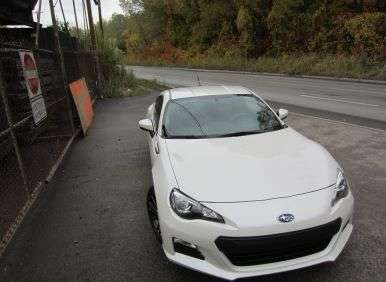Recent Articles
Popular Makes
Body Types
2013 Hyundai Veloster Turbo vs. 2013 Subaru BRZ.Competitive Comparison
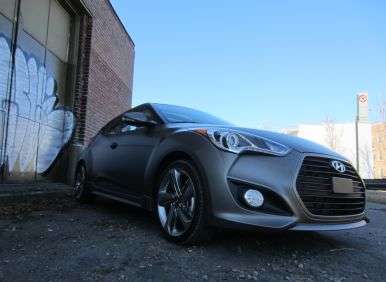
It has been a banner year for compact performance cars. With the exception of the lamentable regression suffered by the redesigned Honda Civic (which has been addressed with an emergency refresh for the 2013 model year), the past twelve months have seen the introduction of a host of exciting small hatchbacks and coupes onto the market. Automakers as diverse as Scion, Ford, Subaru, Hyundai, and even Chevrolet have made new efforts to appeal to those seeking affordable, fun-to-drive cars that can deliver startling levels of acceleration and handling.
We decided to pit two of the most distinctive sporty compact cars head to head - the 2013 Hyundai Veloster Turbo and the 2013 Subaru BRZ - to compare and contrast the very different approaches taken by their respective manufacturers when it comes to delivering cheap thrills to automotive enthusiasts. It's a battle of turbo versus boxer, rear-wheel drive versus front-wheel drive, and practicality versus sleek styling. In short, it's a fight for the dollars of compact car fans who are faced with a difficult choice between two cars that, on paper, appear to be within spitting distance of each other. From behind the wheel, however, the driving experience offered by each of these vehicles tells its own unique story.
2013 Hyundai Veloster Turbo vs. 2013 Subaru BRZ: Pricing and Trim Levels
The 2013 Hyundai Veloster Turbo is offered in a single trim level that starts at an MSRP of $21,950. The Veloster Turbo comes with an impressive level of standard equipment (including heated leather seats), but it's possible to add a number of options such as an automatic transmission ($1,000), matte gray paint ($1,000, which our test vehicle had), as well as the Ultimate Package (panoramic sunroof, navigation system, parking assistance, rearview camera, automatic headlights, 115 volt outlet) for $2,500 and Michelin Pilot Super Sport summer tires for another $1,200. In short order the Veloster Turbo's MSRP can be driven up to the $28,000 dollar mark, if desire.
The 2013 Subaru BRZ starts at an MSRP of $25,495 in its base Premium trim level and features some standard items that are optional with the Veloster Turbo (such as navigation) but doesn't include others (like leather upholstery). For the latter, it becomes necessary to upgrade to the BRZ Limited (MSRP $27,495). Almost no options can be added to the Subaru, although a number of accessories such as a rear diffuser, a spoiler, and other appearance items are on hand to push the final price of the BRZ just past that of the Veloster Turbo.
Winner: The Veloster Turbo's cheap base price will get more butts in seats than the loftier MSRP of the Subaru BRZ, despite the additional gear that comes with the dearer window sticker. Even though fully-loaded models are equivalent in cost, the Hyundai takes this category.
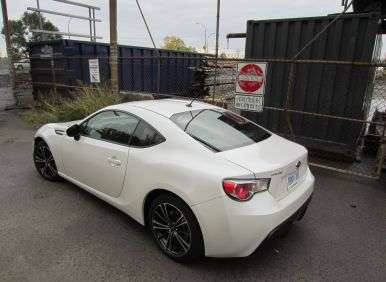
2013 Hyundai Veloster Turbo vs. 2013 Subaru BRZ: Exterior Styling
The 2013 Hyundai Veloster Turbo is an extremely extroverted automobile, especially when finished in the matte gray paint that our test vehicle was slathered in. This unique color scheme is a story in itself, serving as a nod to the tuner community and also posing a challenge for those who want to take the best care of the unique finish. An extensive owner's manual is offered just for the paint, and one has to be careful how the vehicle is cleaned in order to preserve its lack of luster.
In addition to its flat coloring, the Hyundai Veloster Turbo comes with an aggressive front fascia that is festooned with curves, hard angles, and an enormous gaping maw of a grille. The vehicle's beefy fender arches are offset by a deep scallop the runs along the bottom center of its sides, and the rear center exit exhaust compete the Veloster Turbo's aftermarket look. Let's not forget one of the most unusual features of the Hyundai: asymmetrical driver and passenger side doors, with the right side of the vehicle feature a pair of entry points as opposed to the single access offered by the left.
In comparison, the 2013 Subaru BRZ is a much more traditional take on the compact coupe concept. Yes, the BRZ looks very much like a performance car with its grille and air inlet slats and sloped rear greenhouse, but while the vehicle's angled headlights provide an air of menace the car is much more understated than its Korean competitor. In fact, there's really not that much going on to attract the eye to this two-door design other than the side fender grilles and the nicely-tucked dual exhaust tips. The rest of the car is unadorned, relying on its simplicity and its stance to convey that it means serious business out on the motorway. This is not an unsuccessful strategy, but it's one that pales alongside the efforts made by Hyundai's designers.
Winner: It's not necessarily beautiful, but the Hyundai is definitely much more interesting to look at. The Veloster Turbo stands far, far apart from the rest of the compact class in terms of taking risks with design, with only similar models like the Ford Focus ST coming close to matching its 'fluidic sculpture' looks.
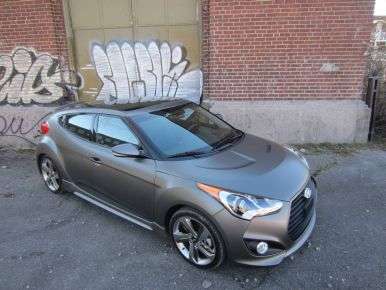
2013 Hyundai Veloster Turbo vs. 2013 Subaru BRZ: Interior Styling And Features
The 2013 Hyundai Veloster Turbo's interior packaging succeeds in some ways, but falls short in others. As is typical of Hyundai's small cars, the vehicle's dashboard, controls, and gauges were attractively arrayed on the dashboard and the center stack, and we were able to quickly bring ourselves up to speed with the navigation and entertainment features. The Veloster Turbo's leather seats and excellent materials quality throughout the cockpit made it feel like we were driving a much more expensive car, which is not always the case in the tuned compact hatchback segment.
Our caveats had to do with compromises associated with the Veloster Turbo's unusual design. The dramatic sloping of the rear roof significantly intrudes on rear headroom, with even shorter occupants glancing their heads off of the ceiling while seated out back. This is a shame, because the second door on the passenger side is quite convenient for accessing the back quarters, and leg room is also strong. We additionally discovered an unusual characteristic of the split rear window offered by the Veloster: during colder weather the exhaust system would almost instantly fog up the glass and make it impossible to see out the back. This is presumably due to the proximity of the center exhaust tips to the shallowly-angled window. Finally, the giant panoramic sunroof outfitted to our test car let in a ton of light, but it also squeaked in the cold, especially over rough pavement.
The 2013 Subaru BRZ's interior follows a very different philosophy than that offered by the Hyundai. Right off the bat, you'll need to forget carrying more than a single passenger in the coupe - this is a two-seat vehicle with a couple of vestigial buckets behind the driver purely to help keep insurance costs down. That being said, the front two positions - cloth-covered in our test vehicle - are amongst the most supportive thrones in the segment. The bolstering on these seats is absolutely perfect and keeps occupants firmly planted even when careening through a road course corner at a high rate of speed.
The vehicle's dashboard is far simpler than that of the Veloster Turbo, with the driver facing an oversize tach, a gimmicky analog speedometer to the left, and a digital speed readout nestled inside the rev counter that is much more practical for everyday use. The vehicle we drove featured an absolutely awful Pioneer navigation and stereo system that should be avoided at all costs, but we were happy enough with the dials and buttons on the center stack. We could have done without the leather boot and trim around the parking brake coming off every time we used it, however.
Winner: It's too close to call here. While the Veloster Turbo's interior is extremely well executed, the BRZ shouldn't lose points simply because it is more focused on delivering a pure, performance-oriented environment rather than an infotainment extravaganza. It's tempting to award the win to Hyundai based simply on the awful nav system found in the Subaru, but oh, those seats. Those seats make everything ok.
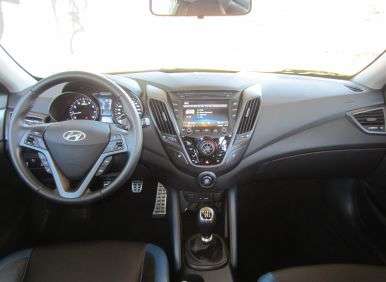
2013 Hyundai Veloster Turbo vs. 2013 Subaru BRZ: Engines and Fuel Economy
The 2013 Hyundai Veloster Turbo comes with a 1.6-liter, turbocharged four-cylinder engine that generates 201 horsepower and 195 lb-ft of torque. A six-speed manual transmission is standard, but a six-speed automatic can be ordered as an option, and fuel economy for the Veloster Turbo checks in at 24-mpg city and 35-mpg highway with the manual unit installed.
The 2013 Subaru BRZ is outfitted with a naturally-aspirated, 2.0-liter flat four-cylinder engine that can be counted on to produce 200 horses and 151 lb-ft of torque. Like the Hyundai, transmission choices include six-speed manual and six-speed automatic units, with the manual edging ahead in the fuel mileage department by virtue of its 25-mpg city and 34-mpg highway rating.
Winner: While it might seem as thought the Veloster Turbo's torque advantage would translate into livelier performance (with almost identical fuel economy compared to the BRZ), the Subaru wins this category by a country mile. Read on into the next section to find out why.
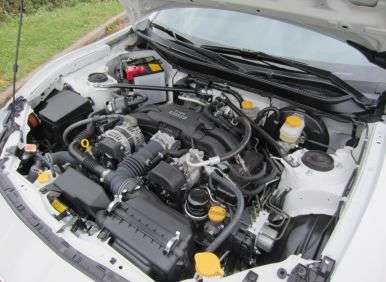
2013 Hyundai Veloster Turbo vs. 2013 Subaru BRZ: Driving Impressions
The 2013 Hyundai Veloster Turbo certain looks the business, and after hitting the ignition button mounted at the bottom of the center console and hearing the turbocharged engine fire up it provides aural reinforcement of its high performance image. Driving the Veloster Turbo at respectable urban speeds is certainly pleasant, but pushing the car to the edge of its design envelope reveals cracks in its sporty façade.
We were pleased with the Veloster Turbo's chassis, which was smooth to turn in to corners, eager to give us feedback about the road, and never became too ruffled when we hit a bump in the pavement before the apex. Comfort was also better than expected for such a small car, although steering at times felt a bit overboosted for our liking, and we found ourselves often slipping our manual transmission test car into third gear instead of first when starting off the line. This caused annoyance and stall-related embarrassment on more than one occasion.
Where the Hyundai began to fall apart was when we asked the turbocharged engine to pour its little heart out in a straight line. Simply put, the Veloster Turbo's 1.6-liter mill suffers from a poorly tuned throttle that essentially shuts down power delivery on the one-two or two-three shift when the pedal is mashed to the floor. With the traction control, stabbing at the gas pedal after completing a shift doesn't build more revs but rather results in a second or two of hesitation before the resumption of forward momentum is permitted. Turning off traction control alleviated the problem somewhat, but not entirely, which lead to us being turned off by not being able to use the hatchback's turbocharged horsepower to its fullest.
The feeling of disconnect engendered by the laggy, delayed throttle response of the Veloster Turbo was the polar opposite of how the 2013 Subaru BRZ reached out and grabbed us by the throat each time we slipped behind the wheel. Even trips to the grocery store and back were highlights in the coupe, whose perfectly-tuned chassis displayed an exceptional willingness to respond to driver inputs and the ability to progressively break the rear wheels free in longer, power-on corners.
The sense of piloting a custom-tailored go-kart was amped up considerably when we took the Subaru BRZ to the track, where it shined in almost every category. The 2.0-liter four-cylinder engine was only too happy to sing all the way up to the redline, let us float the valves between shifts, and then bang through another gear on our test vehicle's manual transmission. With the exception of the terrible Premacy tires that the coupe was wearing during our time with it (units incapable of delivering the grip required in a track environment), the Subaru offered an exceptionally superlative performance that had us grinning from ear to ear.
The balanced, lightweight rear-wheel drive characteristics of the BRZ were a stark contrast to the Veloster Turbo's more industrial torque curve, which would break the front wheels free if throttle application became too rambunctious for road conditions. While we were absolutely in love with the performance of the BRZ, we really did wish for the ability to completely turn off the traction control system, which remained unobtrusive in Sport mode but still took its toll on the vehicle's brakes during its time on-track.
Winner: The Subaru BRZ crushes the Veloster Turbo when it comes to driving fun, as well as in drivetrain smoothness and power delivery. Hyundai is still not quite there when it comes to offering a refined driving experience at the edge, and this came through loud and clear when comparing the coupe to the hatchback.
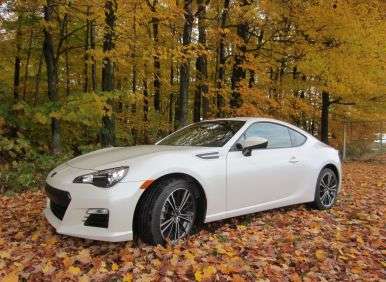
Photo by Benjamin Hunting
2013 Hyundai Veloster Turbo vs. 2013 Subaru BRZ: Safety
The 2013 Hyundai Veloster Turbo features dual-stage forward airbags, seat-mounted side airbags up front, side curtain airbags front and rear, and electronic stability control and traction control as standard equipment. The Hyundai BlueLink telematics system comes free of charge with the hatchback, bringing with it the ability to automatically notify emergency personnel in the event of an accident as well as a tracking feature for stolen vehicles.
The 2013 Subaru BRZ also features with all of the above-mentioned airbags and electronic driver's aides - with the notable exception of a telematics feature like BlueLink.
Winner: Hyundai takes this one, as Subaru needs to catch up and offer something like BlueLink or OnStar in order to remain competitive in the compact segment.
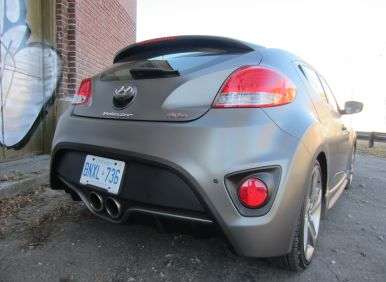
2013 Hyundai Veloster Turbo vs. 2013 Subaru BRZ: Final Thoughts
2013 Hyundai Veloster Turbo vs. 2013 Subaru BRZ: Final Thoughts
Objectively, the 2013 Hyundai Veloster Turbo wins out in this battle, posting three votes to two (with one draw) over the 2013 Subaru BRZ. Fundamentally, however, the Hyundai and the Subaru ask drivers to make specific choices regarding their personal driving preferences. Is the less austere interior, loud styling, and better affordability of the Veloster Turbo more appealing than the BRZ's slavish devotion to performance car purity? Is a rear-wheel drive layout worth paying a premium for in a segment littered with front-wheel drive hatchbacks? Finally, what's more exciting to drive: a turbocharged, highly-tunable motor or a rev-happy boxer engine that needs to be coaxed to the redline to deliver maximum enjoyment?
These intangibles are what test drives are designed to suss out. Just make sure that the dealerships you hit up have a private track available to help you get a full picture of each of these small performance cars.
